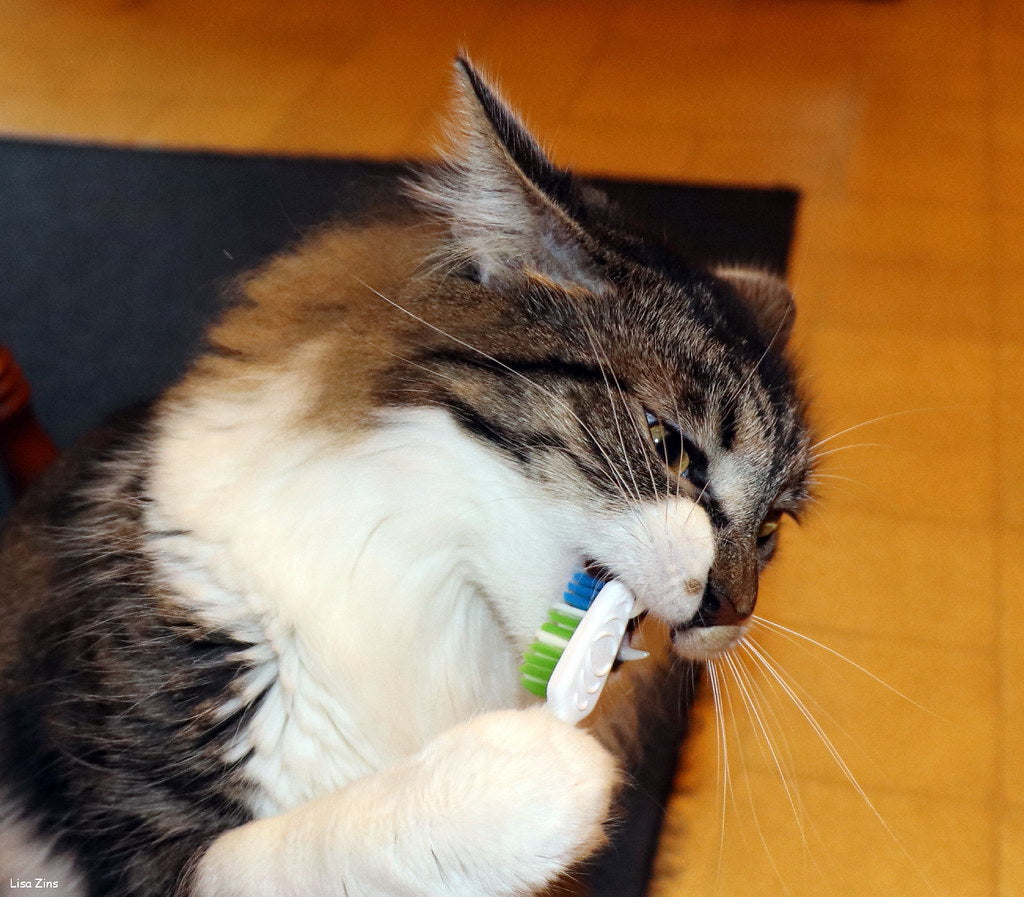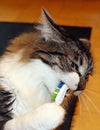
I believe many cat owners did not expect cats to brush their teeth at the beginning. Don’t worry, just like dogs, the cats may also have a series of oral health problems with their age, such as gingivitis, calculus, periodontitis, oral ulcers, etc. When these diseases develop into a certain level, the cat will feel oral pain when eating, which will reduce eating or even hunger strike, which will make the cat gradually lose weight and endanger the health of the cat. If oral problems are serious, anesthesia may be required to clean the teeth or full mouth extraction, and we know that any anesthesia is risky. At this time, not only did the cat suffer, but the Blue Star people also needed to spend more energy and silver to help the cat recover. Therefore, prevention is the most important thing!
A large part of the oral problem is in the initial form of plaque. Dental plaque is caused by food retention and fermentation. Dental plaque can cause calculus or gingivitis, periodontitis, and severe oral ulcers after stimulating the gums. Therefore, the most effective and direct way to prevent the occurrence of oral diseases is to timely remove the plaque by physical friction, that is, brushing your teeth.
It's best to get your cat to habit of brushing teeth every day from kittens, because kittens are easier to control and they have a faster ability to accept new things. It does n’t matter if you have n’t brushed your teeth before, it ’s still too late to pay attention to the cat ’s oral health, and you can still prevent oral diseases to a large extent.
Cats don't like to be forced by nature, and it is difficult to train. So how can you make your cat fall in love with brushing your teeth? We have our own way.
Tooth preparation
The first thing you must prepare is a toothpaste for pet cats. Cats don't spit on their own, so they must use toothpastes for pets. These toothpastes are edible and won't cause harm if they are eaten by the cat; they also contain ingredients that can break down food residues and tartar.
Followed by a pet cat toothbrush or a human baby toothbrush is also possible. If the cat is more resistant to the toothbrush, you can first use a finger cover or gauze for brushing training.
2. Familiarize your cat with the taste of toothpaste
First apply toothpaste on the back of your fingers or hands, and let the cat lick it.
If the cat does not catch cold on the toothpaste, you can also apply the toothpaste on the nose or claws of the cat, so that the cat will lick the toothpaste and become accustomed to the taste of the toothpaste over time.
After several times, the cat can get used to the smell of toothpaste.
3. Get your cat used to being touched by teeth
After the cat is accustomed to the taste of toothpaste, we can rub the tooth with the toothpaste-coated fingers on the tooth to make the cat get used to this feeling. You can use this method to help your cat clean up tartar before it is accepted for use.
When playing with a cat, you can also touch the teeth of the cat from time to time. This can form the habit of the cat's teeth being touched and prepare the cat for brushing.
3. Start brushing your teeth with a toothbrush
Before you start brushing your teeth, you must choose a proper Baoding posture to make the cat feel safe and relaxed, not to escape easily, and not prevent us from brushing our teeth. Generally speaking, let the cat sit on his thigh with his back to himself, and surround him with his arms to make the cat feel surrounded. After the cat is completely accustomed to brushing his teeth, he can change to our sitting position.
When you use a toothbrush to brush your cat's teeth for the first time, remember not to rush into it. Swipe twice on the teeth on the outside of the cat. Too long a time will make the cat feel uncomfortable and impatient. Repeat this action several times a day. Let your cat get used to brushing. If the cat likes to bite the toothbrush, you must find a way to correct this behavior, otherwise not only the toothbrush is easy to damage, but it may also hurt the cat's gums.
The canine and incisors are easier to see, and the molars and cracks hidden in the depths are not easy to observe. For brushing the teeth of the cat, the molars and cracks are the ones we need to focus on. The location. To get the cat to adapt to the habit of brushing teeth, we can start by cleaning some of the teeth we can see, and then gradually deepen it later to achieve the purpose of cleaning all the teeth.
After the cat is accustomed to this routine business, we have to slowly brush the toothbrush in. The process must be gradual. At the same time, after each practice, please remember to give the cat a corresponding reward to let him know that as long as you brush your teeth, good things will happen. The reward can be a cat's favorite snack or play with his favorite toys for a while.
So, cats will soon fall in love with brushing their teeth. Dears, let's move quickly ~


